
|
A Crystalline Herbal and Bestiary: A Journey To An Alien World Part V - The Alien Research Facility by Richard L. Howey, Wyoming, USA |
Visit the Micscape Library to read other parts in the series.
The next morning Consul Zettel and I once again stood before the massive gate of the Alien Research Facility.
“It is imperative that you stay close to me. This facility is very large and labyrinthine and it could be disastrous if you were to get lost. There are many different buildings here with different sorts of security precautions and protocols which must be followed precisely; otherwise you may get cut down by an energy beam.”
I was slightly nervous and excited but so curious regarding the beings housed here that any anxiety was quickly dismissed. The building we entered was a maze of rooms oddly shaped and oddly laid out.

It was know as Z-Red-78 and according to Zettel housed beings seen by only a few thousand scientists and technicians over a very long period of time. As we entered a chamber, sensors turned on soft white lighting. The walls were blank except for one which had masses of control panels.
“What you are going to see is an Entcrid. It is nourished by a narrow spectrum of energy which is how we were able to tempt it here and confine it. The black space in the center is an attractor which apparently has an infinite appetite for that range of energy and you will notice that the area around that black “mouth” is constantly in motion. I am now going to activate the control to raise that panel which will give you a view of it. This shutter will be up for only 5 seconds.

Once the shutter was open, I quickly took a photograph. As you can see, I was unable to get a full image, but the position of the eyes is visible at the top of the image.
“We take these extra precautions because only when we have double opaque shields are we really safe. The Entrcrid destroyed three containment rooms before we built this one which was designed with hundreds of sensors, shielded cameras, and other electronic sensors and surveillance devices. It has destroyed everything but one deeply embedded microscopic microphone over which we hear rumbling sounds suggesting that it is also trying to destroy this room; however, if it breaks out, it will not survive. Before it gradually and systematically destroyed our sensors, we learned that while it feeds on energy, it is highly vulnerable to a chemical response. Any rupture of these walls would give the Entcrid a bath in hydrofluoric acid. If it happened right now, we, of course, would not survive either.”
Zettel started to float away toward the door and I was very glad to follow him and get away from this monstrosity. He sensed my intense unease and said, “We may leave anytime you like. I should warn you that we have creatures here even more nightmarish than the Entcrid.”
“Oh, great,” I thought to myself. “What a terrific pep talk.” However, not wanting to lose face either in the eyes of the Bromonians nor my colleagues on Earth, I cleared my throat and said, “Oh, no. Everything’s fine. I’m glad to observe whatever you have to offer.” A bit of false bravado. (Is there true bravado?) In any case, I saw it as a diplomatic necessity.
“Perhaps, something a bit less extreme is in order for the moment. Let’s take a lock at the Gelvang. It’s a nasty, but only moderately dangerous creature. You can’t miss its brilliant red pigmentation which is related to hemoglobin.”
I managed to get two photographs–one at a distance, the other a close-up of its “head.” You can see them below.


The Gelvang, as I learned, came from a small, weird planet that had parasitic protozoans that feed on a mammal-like creature called Chromasc, huge bovine and not-very-bright organisms, with lots of rich, nutritious, red blood, even though its external appearance gave no hint of this.

When a Chromasc expired from anemia, it would crash to the ground creating ponds of blood. The Gelvang would flock to these ponds and feed. What I previously referred to as a “head” turned out to be a proboscis which it would extend to feed. In the second image above, you can see two of the “X”-like “mouths” which it uses to feed. When the Chromasc blood was not obtainable, the Gelvang would alter its own blood into a powerfully alkaline caustic which it would spray at any potential prey. The caustic would dissolve most hard, protective structures such as shells. Soft tissue would be reduced to a semi-liquid slime which the Gelvang would then slurp up in a disgusting fashion. The reason it was in this facility was in part a consequence of its having very poor eyesight; thus, it sprayed its caustic quite indiscriminately, damaging virtually anything in its range except its special containment room which was lined with special alkaline plastics the Bromonians had developed.
I told Zettel that I found it difficult to imagine that the people working here could deal with these creatures day after day without becoming both neurotic and blas.
He nodded. “Yes. Everyone here is psychologically evaluated on a weekly basis. Scientists often become unhealthily obsessive and sometimes even though they are repelled by a particular alien they are studying, they may nonetheless become totally preoccupied with it and even make jokes about it. So, we screen carefully and systematically and if we find anyone who has developed an undesirable fixation, we immediately feed them to the Krangkasc. Just joking, my dear Professor. Anyone showing signs of disturbance is immediately sent to Janusc which is a rather luxurious resort maintained by the Federation of Scientific Institutes. Furthermore, everyone who works here, after every two months, is required to spend two weeks at Janusc. We cannot afford mistakes here.
Zettel later pointed out to me that as I was approaching my landing on Bromonia and taking lots of pictures, I had without knowing what it was gotten a photograph of a portion of Janusc which you can see below.

This aerial view made it appear to be quite a festive place. Zettel assured me that it was devoted to providing total relaxation and sensory distractions to please every taste–within reason, he quickly qualified. I hoped it wasn’t some Bromonian version of Las Vegas, but I had the feeling that I wouldn’t get a chance to find out.
“I mentioned the Krangkasc. It is a disturbing being. We are not at all sure what it is. One of our researchers dubbed it an ultra-meta-polymorphic mimic. And, of course, one of his assistants, fancying himself a wit, had to counter with–Super-krangkasc-fragile-istic-expedient-alien-oshus. Bright fellow, but a bit of a wise-ass. As you enter the room, you will notice on the left wall a transparent panel which is 3 feet high and 4 feet wide. There is a switch near the top of the panel and just to the right. That will open the outer pane. I suggest you keep your hand on that switch. After that there are 27 layers of high quality optical glass. You will be able to see it and it will be able to see you. A great sacrifice of sand.
We have been its overseer for only a few months–yes, another ‘gift’ from a cargo ship, but this one had only one surviving crew member and the ship could only be used for scrap. We happened on this creature when it was in a vulnerable metamorphosing stage and by sheer luck were able to get it into our containment facility here. We are virtually certain that it has never encountered a humanoid, so it will require 2 or 3 minutes to arrange itself into a copy of you. I think you will find it instructive to take a photograph after about 1 minute so that you can later remind yourself of how dramatic its transmogrification is.”
We entered the room and I stood in front of the panel while Zettel remained off to one side where he could not be seen. I extended my right arm, threw the switch and left my arm poised there ready to throw it again to close the panel at a moment’s notice. At first, all I saw was blackness. Then, after, a few seconds, there appeared a swirl of various colored crystals, predominately, red, white, and grey-green. A few second later, they began to coalesce and rapidly started to arrange themselves. Following Zettel’s advice, I had my camera ready in my left hand and after what I gauged to be approximately a minute, I took the photograph which you see below.
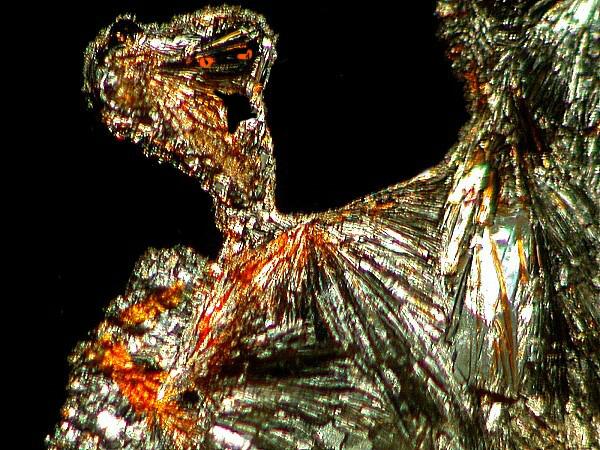
It was even duplicating the raised position of my right arm. The impact of this horrible creature was such that I turned the switch off closing the panel. I was drenched in sweat and shaking. It was simply impossible for me to watch that nightmarish being turn into a copy of me.
Zettel tried to offer a bit of comfort. “Yes, it is hellish and monstrous, isn’t it? What is worrisome for us is that although we know that we can contain it yet for several decades, it is gaining in strength. Furthermore, we are not sure that we can destroy it. Right now, we have a team of 127 scientists working on the problem. The most promising theoretical approach at the moment seems to be finding a way to keep the crystals isolated and prevent them for coalescing. The being has seen me eight times and clearly has an eidetic memory. When I appear in its field of vision now, it can copy me in a fraction of a second. However, on the last two occasions, it has made some rather startling alternations which, I must admit, is rather disconcerting. It’s as though it is making “improvements” on me. Let me show you what I mean. I’ll lower the panel, but only very briefly, so, if you want a photograph, you must be ready.”
I did get an image and I immediately saw what Zettel meant.
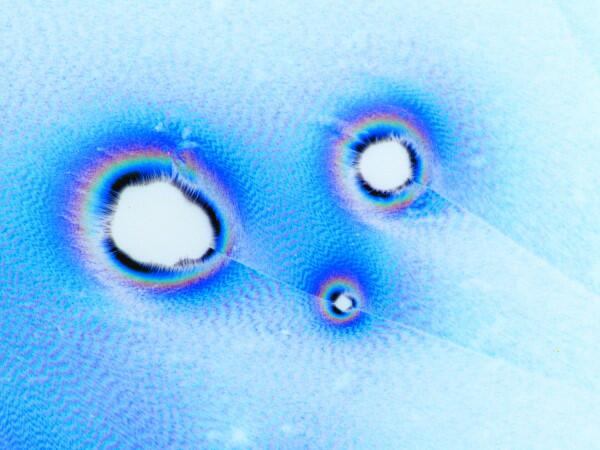
I didn’t know how much more of this I could take and Zettel sensed my mood and proposed that we go up to a roof garden where there was a quite acceptable restaurant that would provide nourishment for both of us. The building was taller than I had realized and part of the restaurant extended out over the edge. It had a transparent bottom and we had a marvelous view of a section of the harbor far below us.
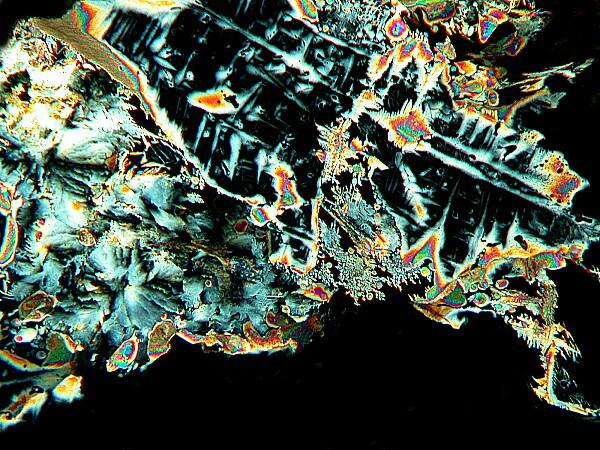
After we lunched, each in our own manner–Zettel apparently survived exclusively on high nutrient liquids–we wandered over to another part of the restaurant where there was a view of one of the magnificent coral reefs along the coast.
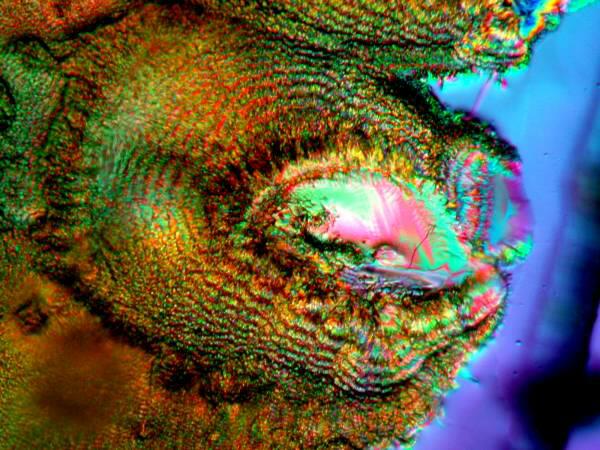
Their rich colors, Zettel told me, were the result of microscopic organisms, some of which I could see when we visited the Bromonian Microscopy Institutes. I had looked up and was pointing my camera out the window when a fantastic creature whizzed past and I just managed to get an image of it.
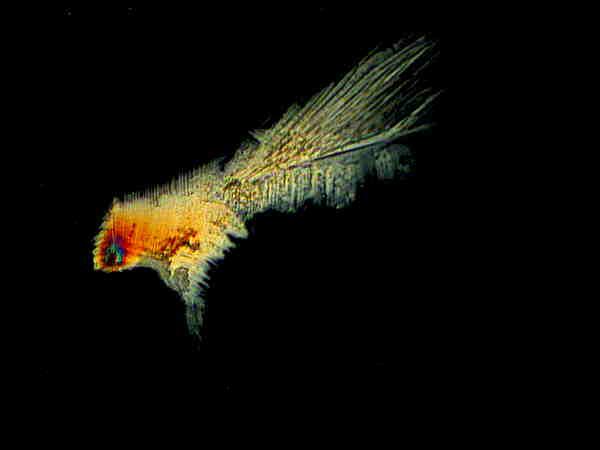
“Now that is amazing,” the Consul remarked. “That is a Kulna which is, in many respects, quite like your flying fish, but I have never heard of one reaching such a great altitude. Truly astonishing! I must update our records.”
Once again, for a few seconds, he went into a trance-like state.
“If I might presume, I should like very much to have a copy of that image you took.”
“My pleasure,” I replied and we headed toward the elevators.
As we descended, he asked me, “Are you sufficiently fortified that you can endure some additional alien encounters?”
“Oh, I think that I’m quite ready. Yes, I’m looking forward to it.”
Zettel looked at me with a slightly skeptical expression. “These encounters are never easy for any of us and especially not for the first time. We are an old race and we have encountered many oddities, but even so it is not always easy for us. I think we’ll begin our return by visiting a rather specialized facility. Even though we are an old race, we have not yet matured sufficiently to have overcome a coarse pleasure in the form of the vulgar humor which you call the ‘pun’. The occupants of this section all have remarkable visual apparatus and some of the local wags have put up signs reading ”The Eyes Have It.”
As you well know, the more complex the eye, the greater the need for a brain or system of neural nets that can process, organize, store and retrieve masses of information. Furthermore, if it is to be successful, it must also be able to filter out vast amounts of irrelevant ‘noise’. In general, the great weakness of sophisticated visual receptors is that they gather too much information indiscriminately.”
He led me to a room that was bathed in a green glow emanating from a creature which he called a Gelcet.
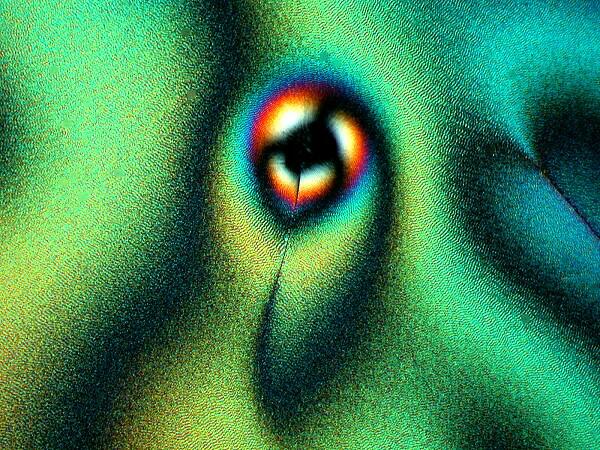
It was a mound of undulating protoplasm with marvelous coloration, but one would be inclined to dismiss it as an extremely primitive organism were it not for its remarkable eye. I couldn’t help indulging in a bit of anthropomorphic projection, for the image suggested to me the outline of a nose and on the far right, the hint of a second eye.
“Unfortunately,” Zettel remarked, “we have not been at all successful in our attempt to communicate with the Gelcet. We have done extensive tests and measurements and what we have discovered is mind-boggling. Apparently, its array of sensory apparatus is virtually entirely disjunctive from ours. From what measurements we have been able to make, there is only a tiny overlap in the visual spectrum. Permit me to project a crude diagram into your mind to illustrate the problem.”
This is what appeared.
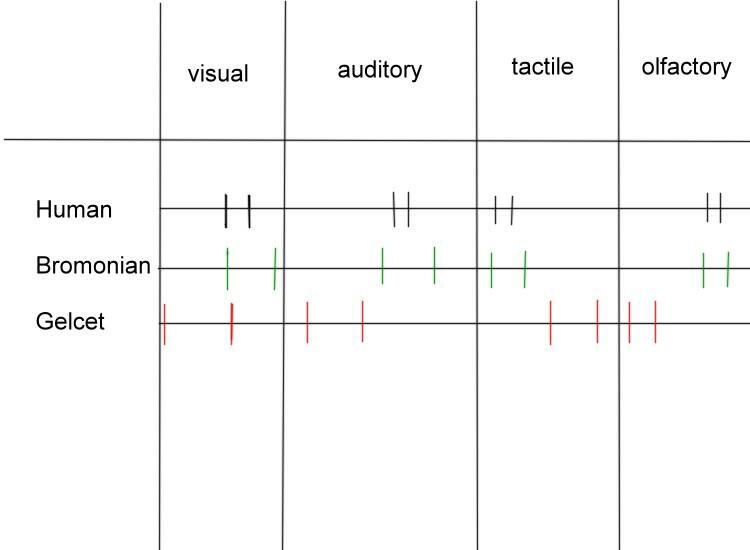
“We were unable to make any measurements regarding gustatory responses, but as you can see, you and I share extensive ranges of sensory responses. However, the Gelcet overlaps with us only slightly at the extreme lower end of the visual light spectrum. We have yet to determine if it is responsive to X-rays, electron beams, alpha particles, etc., but what is clear is that we have virtually no common basis for establishing communication with this being. It could hold untold numbers of secrets to various mysteries of the cosmos and we have no way of ‘talking’ to it. On, the other hand, it could be extremely stupid, but that seems unlikely. From the analyses we have been able to make of the eye, it is staggeringly complex. This is a very frustrating situation for us. Shall we look at some more eyes? Perhaps tomorrow morning. There is a meeting this afternoon which requires my attendance.”
All comments to the author Richard Howey are welcomed.
Editor's note: Visit Richard Howey's new website at http://rhowey.googlepages.com/home where he plans to share aspects of his wide interests.
Microscopy UK Front
Page
Micscape
Magazine
Article
Library
Please report any Web problems or offer general comments to the Micscape Editor .
Micscape is the on-line monthly magazine of the Microscopy UK website at Microscopy-UK .